 |
 |
Curling is played on ice with (approximately) 42-pound granite stones. The size of the playing surface (a 'sheet') is 138 feet long by approximately 14 feet wide. The goal is, after all 16 stones are played (8 by each team), to have a stone of your team's closest to the center of the house, called the 'tee' (see above). This is accomplished by sending your stone to rest in scoring position (a 'draw'), by knocking your opponent's stones out of scoring position (a 'takeout'), and by guarding your own stones with others. The team with the closest stone, inside the house, scores a point, or more if they also have the second closest stone and so on. Each round is called an 'end' and consists of two stones delivered by each player on each four-player team. The stones are delivered from the hack on one side of the sheet to the house on the opposite side. This consists of the player pushing off from the hack with the stone and releasing it with a spin, or 'curl', which gives Curling its name.
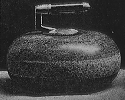 |
The curling stone originated in Scotland from large chunks of rock bowled across the ice, none having any particular size or shape. They evolved into what are now matched sets of fairly uniformly made stones. The are all made of pure granite, and they are amazingly hard. The best stones come from a single granite mine on an island off the coast of Scotland. Shipping is quite expensive due to weight (16 stones in a set at 42 pounds a piece, not including packaging), and manufacturing is expensive because of the toughness of the material, which is ground with diamonds.
 The
stone is concave on both the upper and lower surfaces. On some stones, the degree of
concavity is different on both sides to allow for reversing the stone for 'faster' or
'slower' ice. A handle, usually on a circular plastic disc, is bolted onto the stone
through a channel running through the middle of the stone to a bolt on the other end, as
shown in the red highlighted region in the cross-sectional diagram. The figure on the
right shows the top of the stone, more obviously concave, but without a smooth running
surface. The handle is affixed onto this circular surface.
The
stone is concave on both the upper and lower surfaces. On some stones, the degree of
concavity is different on both sides to allow for reversing the stone for 'faster' or
'slower' ice. A handle, usually on a circular plastic disc, is bolted onto the stone
through a channel running through the middle of the stone to a bolt on the other end, as
shown in the red highlighted region in the cross-sectional diagram. The figure on the
right shows the top of the stone, more obviously concave, but without a smooth running
surface. The handle is affixed onto this circular surface.
In the figure above, part A is the bottom of a curling stone, which is concave, although you can't see it well in this picture. The red circle is the actual running surface of the stone. This allows the stone to go farther, more accurately, and pick up more 'curl' than would be possible on a flat surface.
 There is a
lighter-colored band in a ribbon around the curling stone. This is the 'striking surface'.
In manufacturing, the entire stone if very highly polished. This surface is dulled down
for the purpose of improving collisions with other stones, both so that there will be a
larger contact patch in the collision and so that the stones will not chip.
There is a
lighter-colored band in a ribbon around the curling stone. This is the 'striking surface'.
In manufacturing, the entire stone if very highly polished. This surface is dulled down
for the purpose of improving collisions with other stones, both so that there will be a
larger contact patch in the collision and so that the stones will not chip.
The stone is delivered sort of similarly to a bowling motion. Actually, it's not that similar, but it's the only thing that even resembles it. You start off at what's called a 'hack', or basically a block sticking out of the ice.
 Your
first motion is to take the stone and pull it backwards, frequently lifting it off the ice
in the backswing, then you swing it forward into a smooth glide down the ice.
Your
first motion is to take the stone and pull it backwards, frequently lifting it off the ice
in the backswing, then you swing it forward into a smooth glide down the ice.
 However, to deliver a stone well, you should glide along with the stone as far as
possible.
However, to deliver a stone well, you should glide along with the stone as far as
possible.
 Good
curlers usually glide very close to the ice, in an odd, very stretched pose.
Good
curlers usually glide very close to the ice, in an odd, very stretched pose.
 You
must release the stone by the 'hog line' (see at the top of the page, the diagram of the
rink)
You
must release the stone by the 'hog line' (see at the top of the page, the diagram of the
rink)
 As
you slow down, the stone glides on, to come into play on the opposite side, beyond the
other hog line.
As
you slow down, the stone glides on, to come into play on the opposite side, beyond the
other hog line.
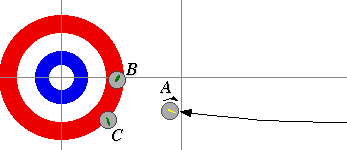 |
Curling is always mentioned as a game of strategy by curlers, partly because it is, but also probably because they want to make sure that it's seen as more than throwing rocks and slipping around on the ice.
Strategy is definitely the big thing in competitive curling, though. A great deal of effort goes into planning an end so your team's stone ends up closest to the center. There are a bunch of different strategic moves, and here we show the standards:
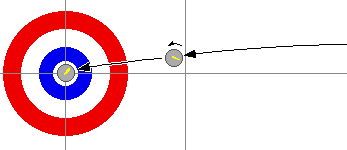 The Draw
The Draw
A 'Draw' is obviously the most basic move. You send the stone down the sheet, and with the
help of the sweepers and the direction of the skip, you somehow get the stone to stop
where you want it. Here is shown a perfect draw into the Tee, the center of the House.
This would be fairly pointless as a first shot, as it could easily be taken out.
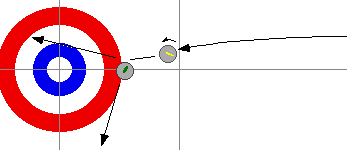 The Takeout
The Takeout
Here, the green stone is taken out by the yellow. The yellow continues on, maintaining
most of its momentum (usually takeouts are thrown harder than draws), while also knocking
the green stone out of play. The yellow stone could, of course, remain in play if it
remained in bounds, but in a basic takeout, the only concern is removing the other team's
stone.
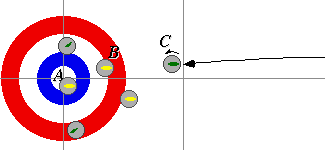 Guarding
Guarding
Guarding is, as its name implies, placing a stone in front of another (with a draw) to
prevent a takeout. In this diagram, we see two green stones and three yellow stones that
have already been played. To protect stone A, the yellow team has sent a draw, stone B,
immediately in front of A. This prevents a takeout by stone C as would have happened here.
A large element of the game not mentioned so far is the 'curl' of the stone. As you can see in the above diagrams, the stone is not coming in on a perfectly straight path. This is due to the curl put on the stone by the curler. As the stone is delivered, a slight spin is put on it, acting like a very, very slow curveball.
 The pebble is what helps the stone pick up the lateral motion. As is
seen here, the ice is sprinkled before the game with a 'pebbler', which creates a smoothly
hilly effect on the ice, much like little pebbles. Without the pebble, the stone would not
be able to travel as far. Our best guess, based on what we've been told by people who
know, is that the small travelling surface of the stone itself combined with the small
contact area of the ice (created by the pebble) creates the same effect you get when you
brake on an ice patch. A thin film of water on top of ice creates a hydroplane. Using
brooms, the sweepers slightly warm the pebble and thereby increase this effect, causing
the stone to glide farther and grip less (which also has the effect of lessening the
lateral motion due to curl).
The pebble is what helps the stone pick up the lateral motion. As is
seen here, the ice is sprinkled before the game with a 'pebbler', which creates a smoothly
hilly effect on the ice, much like little pebbles. Without the pebble, the stone would not
be able to travel as far. Our best guess, based on what we've been told by people who
know, is that the small travelling surface of the stone itself combined with the small
contact area of the ice (created by the pebble) creates the same effect you get when you
brake on an ice patch. A thin film of water on top of ice creates a hydroplane. Using
brooms, the sweepers slightly warm the pebble and thereby increase this effect, causing
the stone to glide farther and grip less (which also has the effect of lessening the
lateral motion due to curl).
Each player shoots or delivers two stones each end, or inning, alternately with their counterpart on the opposing team. A twist of the handle on release makes the stone curl, a little like a "hook" in bowling.
All four team members shoot two stones an end and sweep for their teammates' shots. While one player shoots, two sweep as needed. Sweeping posishes the ice so the stone travels farther if delivered too softly, and vigorous sweeping requires fitness. In a typical two hour game, a curler walks almost two miles.
The skip acts as team captain and strategist. Strategy is a major factor in curling, as important as shooting skill. Some people call curling "chess on ice".
The playing surface is called "a sheet of ice", and is designed to allow play in both directions.
The object of shooting is to get the stone, or rock, to come to rest at a predetermeined place (a draw or guard) or to move another rock (a takeout or raise).
The score is determined after each end of 16 stones. See the example illustrated at bottom right. A 12 foot circle, the house, is the scoring area. Stones in the house must be closer to the tee (center) than any opposing stone to score.
The maximum score in one end is eight points. Typically, one to three points are scored. Games are 8 or 10 ends, lasting 2 to 2.5 hours.
So, there it is.That explanation didn't include the very basics -- which are, basically, that you use the
hack (see below) to push off, you with the stone. You travel with the stone. You must
release it by the 'hog line' on your side. To count as a valid shot, it must make it past
the hog line on the other side. The form is sort of shown on the previous page. The stick
guy with the very long neck has just delivered the stone, and it's on its way to the
opposite 'house'. People who are really good seem to move effortlessly halfway down the
sheet after they've released the stone. You use the broom to support your left side
(assuming you're right-handed). You slide on your left foot, with your right leg stretched
out behind you, dragging, as you lean far forward to release the stone with your right
arm. Pictures are coming soon, but it's a bit of work to scan them, etc.

Thanks to the Brown Curling Club for the info!